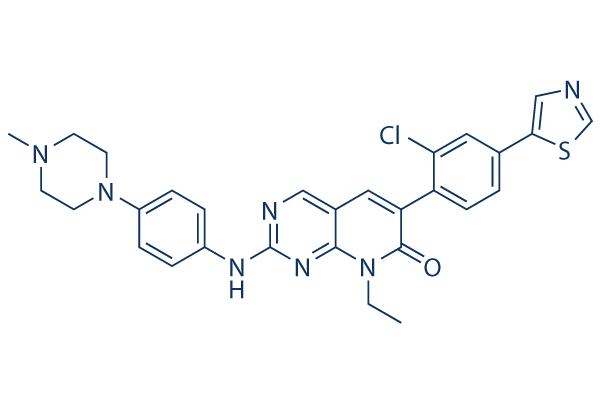All AbMole products are for research use only, cannot be used for human consumption.

In vitro: FRAX597 (100 n M) displays a significant inhibitory capacity toward YES1 (87%), RET (82%), CSF1R (91%), TEK (87%), PAK1 (82%), and PAK2 (93%), while displays minimal inhibitory activity towards the group II PAKs: PAK4 (0%), PAK6 (23%), and PAK7 (8%). FRAX597 treatment dramatically impairs the proliferation of Nf2-null SC4 Schwann cells (SC4 cells). FRAX597 displays an IC50 value of 48 nM against wild type PAK1, while IC 50 values against the V342F and V342Y PAK1 mutants are higher than 3μM and 2 μM, respectively. FRAX597 inhibits the proliferation and motility of both benign (Ben-Men1, 3μM) and malignant (KT21-MG1, 0.4 μM) meningiomas cells after treating of 72 h. In vivo: In NOD/SCID mice which bearing Nf2-/-SC4 Schwann cells, FRAX597 (100 mg/kg/day, p.o.) causes more significant tumor growth inhibition cpmpared with control mice. In SCID mice with orthotopic meningioma, FRAX597 (90 mg/kg/day, p.o.) significantly suppresses tumor growth.In KrasG12D mice, treatment with FRAX597 (90 mg/kg/day, p.o.) causes tumor regression and loss of Erk and Akt activity.
| Molecular Weight | 558.10 |
| Formula | C29H28ClN7OS |
| CAS Number | 1286739-19-2 |
| Solubility (25°C) | 14 mg/mL warmed in DMSO |
| Storage |
Powder -20°C 3 years ; 4°C 2 years In solvent -80°C 6 months ; -20°C 1 month |
| Related PAK Products |
|---|
| st-Ht31
st-Ht31 is a membrane-permeable peptide inhibitor of protein kinase A (PKA) anchoring. |
| AZA197
AZA197 is a selective small molecule inhibitor of Cdc42.AZA197 suppresses colon cancer cell proliferation, cell migration, invasion and increases apoptosis by down-regulating the PAK1 and ERK signaling pathways in vitro. |
| ZMF-23
ZMF-23 is a PAK1/HDAC6 dual inhibitor. |
| PF-3758309 dihydrochloride
PF-3758309 (PF-03758309) dihydrochloride is a potent, orally available, and reversible ATP-competitive inhibitor of PAK4 (Kd= 2.7 nM; Ki=18.7 nM). PF-3758309 dihydrochloride has the expected cellular functions of a PAK4 inhibitor: inhibition of anchorage-independent growth, induction of apoptosis, cytoskeletal remodeling, and inhibition of proliferation. |
| AZ13705339 hemihydrate
AZ13705339 hemihydrate is a highly potent and selective PAK1 inhibitor with IC50s of 0.33 nM and 59 nM for PAK1 and pPAK1, respectively. AZ13705339 hemihydrate has binding affinities to PAK1 and PAK2, with Kds of 0.28 nM and 0.32 nM, respectively. AZ13705339 hemihydrate can be used in the research of cancers. |
All AbMole products are for research use only, cannot be used for human consumption or veterinary use. We do not provide products or services to individuals. Please comply with the intended use and do not use AbMole products for any other purpose.


Products are for research use only. Not for human use. We do not sell to patients.
© Copyright 2010-2024 AbMole BioScience. All Rights Reserved.
